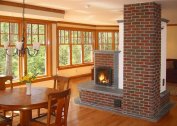To equip the underfloor heating system, a suitable adhesive composition is required. The selected product should have high strength and elasticity, to maintain its properties at temperature extremes. Therefore, among a large assortment, you need a suitable mixture, having studied in detail its qualities and operational characteristics.
Types of underfloor heating
The installation procedure for different heated systems may vary. Therefore, you need to pay more attention to what surface tile adhesive for underfloor heating will be applied.
Electric
Such floors are divided into film and cable. Tiles are not used for the film floor, since the design is not repairable, which makes it disadvantageous. If a cable underfloor is laid, mats are used, having the form of a cable laid on the footboard with a net, or a cable element laid out by a snake. It is attached with tapes.
Most manufacturers recommend laying the floor with adhesive or screed. If an adhesive was chosen, you need to find out what will be the basis for the cable:
- cement or concrete;
- wooden base, for example plywood or chipboard;
- synthetic base;
- bitumen or polymer.
Only on such materials can the cable be laid using tile adhesive for underfloor heating.
Water
This design consists of pipes and mats. Pipes are placed on mats that have a curly or solid appearance. When the mats are continuous, a reinforcement mesh is applied, on which the heating elements are placed.
From above, this system is poured with a screed, its thickness should be 3-7 cm. A solution is selected that is suitable for the base in the form of concrete.
When the water floor is installed on a wooden layer, the pipes are mounted in special recesses, which are in the form of a plate with a heat-reflecting effect. These plates, in turn, are placed in the recesses in the floor. Plywood with increased moisture resistance should be used, its thickness should be 1 cm.
If a plywood floor is used, you need a mixture suitable for wood, it is more elastic.
Infrared
This floor is laid under a laminate or linoleum. Infrared rays affect all objects that are indoors, warming them. Also warms up the air in the room.
There are two types of infrared floor:
- pivotal;
- film.
The core floor consists of carbon elements, whose length reaches 80 cm. During installation, they are poured with a concrete screed, a layer of 2-3 cm. After the tile is laid, a solution suitable for concrete is used.
The film floor may be carbon or carbon. Both species are 0.4 mm thick film. This allows you to mount it directly on the screed. The composition for linoleum is used.
Adhesive classification
Glues include various components. Therefore, before choosing, you should learn about its varieties.
One component
The mixture is convenient to use, because it is supplied in special buckets in an already prepared condition. The composition of such adhesives includes resins, acrylic, modifiers. Mixes harden in 20 minutes that gives the chance of correction of the laid tile.
Two-component
Knead from two components before starting work. Created on the basis of epoxy resin and parts of polyurethane.The glue is able to tolerate temperature changes, has significant elasticity and adhesion properties. It freezes quickly, keeps on any surface.
Universal
This type of glue is created on a Portland cement basis with the addition of sand and plasticizers. It is the most popular of all types of adhesive solutions. It is sold in dry form, prepared in warm water before laying work. The proportions are indicated on the package.
Specifications
Solutions have certain characteristics, thanks to which you can choose glue for any surface. The characteristics are as follows:
- anti-slip - the mixture holds the material firmly on the floor;
- characteristics retention time - usually from 1 to 3 hours, during which the composition does not change its properties;
- working life - for simple glue, it is in the range from 10 to 30 minutes, quick-drying solution - from 5 to 10 minutes;
- correction time - on average, this interval is 20 minutes, during which you can correct the position of the tile.
These properties will allow you to choose the glue for a certain surface and help to adjust the time allotted for laying.
Use technology
Foundation preparation
Before starting, you need to prepare the base. This is done according to the instructions:
- dust, debris and other objects are removed from the floor and screeds, you can vacuum;
- primer is applied to the surface, this will improve adhesion
- the surface is finally dried.
After the operation, you can begin to create an adhesive solution.
Features of the preparation of glue
To prepare the mixture, you must perform the following steps:
- the proportions will be indicated on the package, it is necessary to follow them;
- after mixing the ingredients, add water;
- the composition is applied to the screed and leveled with a spatula.
It is recommended to spread the mixture gradually in order to have time to lay the top layer of the floor.
Features of tile laying
The tile is prepared in the following way:
- to increase adhesion, it is possible to primer the tiles from the inside;
- the mixture is applied to the material, the minimum thickness of the solution is up to 0.5 cm;
- the tile is laid, equal gaps should be maintained between its parts, plastic crosses can be used, which are removed after 2 hours.
After the substance has completely dried, grouting is carried out.
Adhesive Selection Criteria
To lay a warm floor, you need to choose a composition that has the following characteristics:
- resistant to temperature extremes, able to transfer the range from -30 to +90 degrees without loss of quality;
- coupling level must be at least 0.8 MPa;
- must be compatible with many surfaces, this is indicated on the package;
- ease of use - finished components in the package;
- acceptable price;
- the composition should include components that will make it resistant to loads and impacts.
If in doubt when choosing glue for porcelain stoneware or other material for underfloor heating, you should consult a specialist.
Rating of popular manufacturers
Glue Ceresit for a warm floor has a high degree of elasticity, can be used for various coatings, the service life extends for many years. It is also environmentally friendly and safe for human health. It can tolerate sudden changes in temperature. It is important to comply with the requirements on the packaging.
Solution Bergauf for porcelain stoneware, it quickly dries to the warm floor, you can walk on it 4 hours after the end of work. You can change the position of the tile within 10 minutes after application. It tolerates temperature differences from -10 to 70 degrees. Recommended for people who have experience in such work.
Glue Knauf used for laying on a complex base, for example gypsum fiber coating. The solution has a high degree of elasticity and adhesion, increased waterproofing. You can correct the laid tile within a few minutes after application. Withstands temperature extremes from -30 to 80 degrees.









